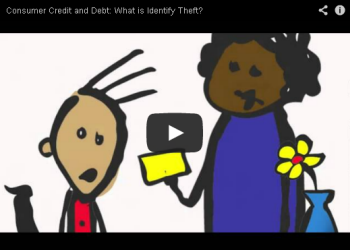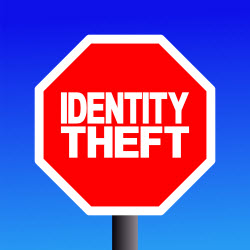Difference between revisions of "Identity Theft"
| Line 22: | Line 22: | ||
* commit more crimes and, if arrested, use your identity. | * commit more crimes and, if arrested, use your identity. | ||
[[File:IdentityTheftAnimation.png|link= | [[File:IdentityTheftAnimation.png|link=http://www.youtube.com/watch?v=mvbxcgKRL5Q&list=UUSstQuUfC1NQphZOL_onOuw&index=28|right|frame|400px|[http://www.youtube.com/watch?v=mvbxcgKRL5Q&list=UUSstQuUfC1NQphZOL_onOuw&index=28 What is Identify Theft?] An animation that discusses identity theft and steps you can take to address the problem.]] | ||
==How do they get the information?== | ==How do they get the information?== | ||
Revision as of 19:42, 15 March 2013
| Update: This page is in the process of being updated and the content is not to be relied on. |
Identity theft happens when someone takes the personal information of another person and uses it without their knowledge or consent. Identity theft is one of the fastest growing crimes in Canada and can happen to anyone. By being aware of the issue and by managing your personal information wisely, you can help guard against identity theft.
What does identity theft mean?[edit]
Identity thieves steal your name and other pieces of personal information such as address, date of birth, Social Insurance Number (SIN), credit card numbers, bank numbers, online passwords, calling cards, birth certificates, passports, and your mother’s maiden name.
Once they steal information, identity thieves invade your personal and financial life. Using this information, they may:
- drain your bank accounts, transfer bank balances or open new accounts,
- run up credit card debts or apply for new credit cards,
- apply for loans and other services or benefits,
- go on spending sprees involving the purchase of vehicles, apartments, luxury items and vacations, or
- commit more crimes and, if arrested, use your identity.

How do they get the information?[edit]
Identity thieves can obtain your personal and financial information in a range of ways. For example, they may:
- Steal the information from your computer, smartphone, wallet or purse, home, or vehicle.
- Pose as a credible person (e.g., government official, bank employee, landlord, employer, creditor, service provider) to obtain your personal or financial information from you or from confidential sources.
- Remove mail from your mailbox or redirect your mail.
- Tamper with automated teller machines (ATMs) and point-of-sale debit machines so they can read your debit or credit card number and personal identification number (PIN).
- Retrieve personal information from garbage or recycling.
- Buy the information from someone who works where personal and/or financial information is stored.
- Use online search engines, social media networks, newspapers, phone books, and public records to obtain your information.
- Place bogus advertisements for employment in order to obtain your information.
- Pretend they need your personal details to send you “winnings”.
Warning signs[edit]
- You find withdrawals or transfers you didn’t make in your bank accounts.
- Your credit card statements show items you didn’t purchase.
- You notice that not all of your mail is arriving on time.
- You get credit card statements for accounts you don’t have.
- You start getting bills from companies you know nothing about.
- A creditor calls to say you’ve been approved or denied credit you haven’t applied for.
- You apply for credit and are turned down for no apparent reason.
- A collection agency tries to collect on a debt that isn’t yours.
What you can do to minimize the risk[edit]
Immediately notify the issuer if you think any of your identity documents may be lost or stolen. Here are some strategies you can use to minimize the risk of someone stealing your identity.
Online[edit]
- Use passwords that do not contain easily available information.
- Don’t download applications unless you can verify the source. Never give personal information to “unlock” a feature or application.
- Have the most recent updates installed for spam filters, anti-virus and anti-spyware software, and a secure firewall. Use the most up-to-date versions of your web browser to offer further protection.
- On a social networking site, don’t post more personal information than necessary. Set your privacy settings as high as possible. Do not accept friend requests from people you don’t know.
- Never follow links in emails, even to log in to Facebook or Twitter. Go to the site directly and log in there.
- If you use secure sites for financial transactions, follow all of the instructions for security when you enter and exit the site.
- Don't send personal and financial information by email unless you know the service is secure.
- Make sure personal information is deleted before you sell, recycle or discard your computer. You may have deleted files from folders but the information may still be on the computer’s hard drive.
On your mobile devices[edit]
- Password protect your smartphone and lock the keypad when you're not using it. Ensure you enable the password or PIN to all your voice mail accounts.
- Don't share any important information, account numbers or passwords via text message. Text messages are relatively easy to intercept.
- Carry only the information you need on your phone. Just because you can list contacts in a smartphone application doesn't mean you should do it.
- If you carry important information on your smartphone, consider using software that can remotely lock your phone or remove your information.
In everyday transactions[edit]
- Give your SIN only when absolutely necessary, and do not carry your SIN with you.
- Never give personal or financial information to anyone who contacts you by phone or online unless you know who they are or can confirm they are legitimate.
- Be aware that police and financial institutions never call or email to ask for your bank or credit card details or PIN.
- Tear or shred receipts and copies of papers you no longer need, such as old tax returns, insurance forms, and credit offers you get in the mail.
- Don't leave personal information lying around at home, in your vehicle, at the office or on your computer. Don’t leave receipts at an ATM, a gas station, or anywhere else where you are purchasing goods or services.
- When you receive a renewal or replacement for a document that contains identity information (e.g., your driver’s licence), return or destroy the old one.
- Sign your credit and debit cards as soon as you get them. Cut up expired and unused cards.
- Keep key documents such as your birth certificate, passport and social insurance card in a safe place when you’re not using them. Also keep other important documents such as tax returns, will, marriage certificate, diplomas and degrees in a safe place.
- Make a list of the names, account numbers and expiration dates of your cards in a secure place. Store this list somewhere secure. This will help you if you need to alert your credit grantors about a lost or stolen card.
- Know when your credit card and financial statements and utility bills are due. Pay attention to credit card expiry dates. Match credit cards and debit cards to your statements.
- Do not put more than your name and address on your personal cheques.
- Lock your household mailbox if possible. Pick up your mail promptly. When you are away, have a trusted person pick up your mail.
What you can do if your identity is stolen[edit]
Dealing with identity theft is time-consuming. You need support and information. This section suggests actions you can take to stop the thief and regain control of your identity documents.
If you suspect you have become a victim, you need to contact financial institutions, credit issuers, other companies and credit reporting agencies. Keep a log of dates, person(s) that you speak with or write to, what they say, and how to contact them again if you have more questions.
- Report the incident to the Canadian Anti-Fraud Centre (CAFC) at 1-888-495-8501 or www.antifraudcentre-centreantifraude.ca. The CAFC has an Identity Theft Statement you can use to send to financial institutions, credit issuers, other companies and credit reporting agencies. You can download it from the website and make copies.
- Contact your financial institutions, credit issuers, and other companies. Tell them what has happened and ask them to investigate. Cancel any cards that were affected and close any affected accounts. Find out if the company requires written documentation to begin investigating your claim of identity theft. Send the company the documentation they require as soon as possible.
- Contact Canada’s two major credit reporting agencies. Ask each agency to send you a copy of your credit report. The credit report may show if there are other companies where the identity thief has opened accounts or incurred debt in your name. Discuss with the credit reporting agency whether to have a “fraud alert” placed on your file. A fraud alert means that creditors call you before opening any new accounts or changing your existing accounts. The two major credit reporting agencies are:
- Equifax: Phone toll-free at 1-800-465-7166 or visit their website at www.equifax.com.
- TransUnion Canada: Phone toll-free at 1-800-663-9980 or visit their website at www.transunion.ca.
- If your government-issued documents were lost or stolen, contact the department or ministry, explain what happened, and request new documents.
- If you think your mail is being stolen or re-directed, contact Canada Post.
- Report the incident to your local police department. Ask the police to take a report, if possible. If a police report is available, include it in all your correspondence about the identity theft with financial institutions, credit issuers, other companies and credit reporting agencies.
| |||||||||||||||||||||||

